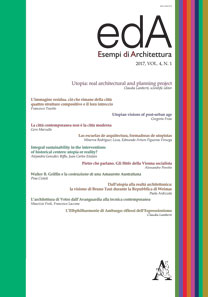Estratto da
ESEMPI DI ARCHITETTURA
International Journal of Architecture and Engineering
Dall’utopia alla realtá architettonica: la visione di Bruno Taut durante la repubblica di Weimar. From utopia to architectural reality: Bruno Taut's vision during Weimar Republic
ESEMPI DI ARCHITETTURA
International Journal of Architecture and Engineering
Dall’utopia alla realtá architettonica: la visione di Bruno Taut durante la repubblica di Weimar. From utopia to architectural reality: Bruno Taut's vision during Weimar Republic

In the complexity of historical events that characterized the early 20th century in Europe, after World War I Germany experienced a time of serious economic crisis together with a misperception of values. The Country lived a tough building paralysis, because the majority of German economic resources had been funnelled into the war. Bruno Taut interprets the time of crisis as “time of waiting” during which he imagines a renewal of spiritual and social contents according to utopian sense. Ernst Bloch glimpsed in the coeval desperate crisis the end of a decadent world, but also the harbinger of the impending change that identified in a different future the real ontological dimension of man. In the book Alpine Architecture Taut draws unlikely crystal architectures located on the Alps; they represent the pretext for focusing on the crystal as symbol of a regenerated humanity. Against an overruled bourgeois culture, Taut’s vision presents an immaterial architecture as starting point for renewing the human social setting. In later publications The crown of the city and The dissolution of the city, the architect makes a breakthrough towards the architectural reality, proposing both utopian settlements and possible new city patterns. Criticizing the traditional city through effective writings and drawings, the architect highlights the importance of a new relationship between housing cluster and industrial suburb, city centralization and cooperative use of agricultural land. He formulates planning proposals which match utopia and reality, thus establishing the premises of each Siedlung he will design in Berlin between 1924 and 1932. The Siedlung is an innovative housing settlement type intended to become the accomplished expression of the new social dimension of the Weimar Republic; thanks to the utopian premises Taut builds in Berlin thousands of housing units not just according to the famous Neues Bauen formula - Licht, Luft und Sonne - but trying to epitomize those intimately human needs expressed in the utopian-theoretical writings.
| pagine: | 77-86 |
| DOI: | 10.4399/97888548991938 |
| data pubblicazione: | Giugno 2017 |
| editore: | Aracne |








